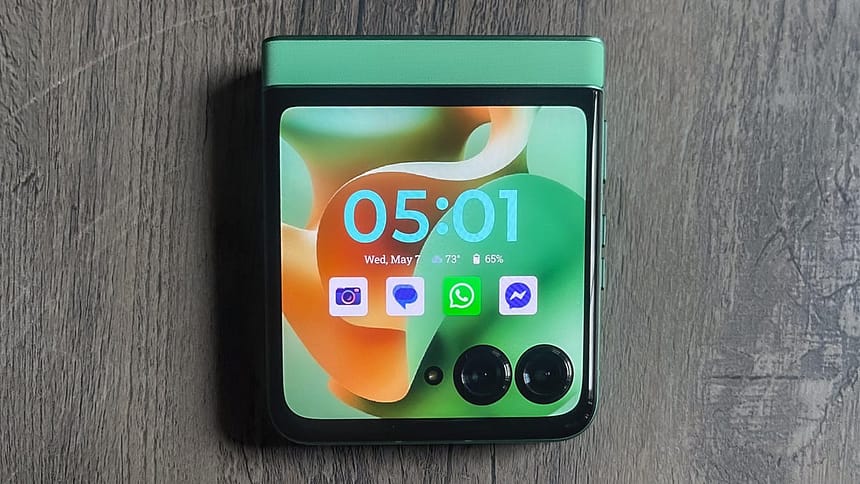It’s amazing what a nice shade of green can do for your mood. After unboxing the 2025 edition of Motorola’s Razr, I was immediately struck by the $700 flip phone’s vivid shade of green — specifically Pantone’s Spring Bud. It’s somewhere between the lightness of mint and the medium shade of flower leaves. Even though I usually put my phone in a case, the Razr’s “leather-inspired” textured back makes me not want to.
That “fun to hold” feeling may be the most notable thing about Motorola’s new Razr line, which gets even more unique with Alcantara fabric and wood options on the $1,300 Razr Ultra. But thanks to the bold color, a cover screen that’s just big enough to knock out the essentials, and a variety of half-folded modes, even this lower-cost edition of the phone feels expressive. The Motorola Razr is a breath of fresh air compared to standard rectangular phones that are typically in the $700 price range.
Motorola is quite aware that the Razr’s striking looks are a selling point to new customers. The company cited during the Razr’s unveiling that 25% of its customers are coming from an iPhone. Since this Razr costs $700, its price is just above value-oriented flagships like the $650 Samsung Galaxy S24 FE — yet lower than an $800 iPhone 16. And even though this year’s base Razr is a refinement of last year’s Razr design, it’s one that remains eye-catching. I still have a lot of testing to do, but I wanted to share some of my early impressions of the Motorola Razr 2025, after using it for a day.
When the Razr is folded like a stand, certain apps will display information like a video on the top half and the controls on the bottom half.
My day with the Razr
The Razr is easy to grip whether it’s open or closed, and having the rest of the phone’s body match the green shade makes it feel fun from the start. The Razr also comes in a Parfait Pink color with a similar leather finish, Gibraltar Sea (blue) with what Motorola describes as a “nylon-inspired” finish, and Lightest Sky (silver) that is “acetate-inspired.”
The Razr’s style and shape made it a fun companion for a dinner out with friends. I kept it folded on the train and used the cover screen to manage my subway directions to a restaurant in Queens. I flipped it open to take a few food and street photos. And I used Moto AI on both screens to look up quick facts as they came up over dinner. All in all, though, one of my friends found the new Razr so cute that she said she wanted to steal it — but because it’s such a pocketable size, she won’t get the chance.
I’ve also enjoyed using the Razr in ways that I simply can’t use similarly priced phones from Samsung and Apple. I often attach kickstands to phones for video calls, but with the hinge, I can instead use the phone half-folded like a stand and (in supported apps like Meta’s Messenger and Google Meet) have the video call on the upper half with call controls on the lower half. When in this stand mode or partly folded like a tent, the cover screen can be set to show ambient information like the time, while a wave of my hand in front of the phone can activate Moto AI for quick questions.
The back of this Razr has a leather-like finish that feels grippy.
More to come with the Razr
As I continue to test this Motorola Razr, I’m focusing on how functional the smaller 3.6-inch cover screen is. That display is like a “mini” phone and is one of the biggest ways the Razr sets itself apart from other sub-$800 phones. You can set it up to run nearly every Android app, as with prior Razr phones.
The Razr is also the entry-level device for Moto AI, which highlights Motorola’s own efforts alongside features built in partnership with Perplexity, Meta’s Llama AI and Microsoft Copilot. Moto AI deeply integrates these services into the phone so it can make suggestions based on what’s on your screen. Separately, you can still summon Google’s Gemini to access the AI services built directly into Android 15.
You can activate Moto AI by waving your hand in front of the screen while the Razr is folded over like a tent.
There are a lot of different ideas inside Moto AI for conducting quick research or organizing data. AI is a particularly competitive space right now, and I hope to see if Moto AI’s features will help me get the most out of the phone’s cover screen.
As a result, this year’s $700 Razr gets to dance on two different stages of interest. It could be a nice minimalist phone, thanks to its cover screen that can do more functions than the $800 Light Phone 3. And it could also serve as a refreshing alternative to buying the $800 iPhone 16 while saving significant money over the $1,100 Samsung Galaxy Z Flip 6. I’ll be seeing how the Razr fits each method as I continue testing it out.






